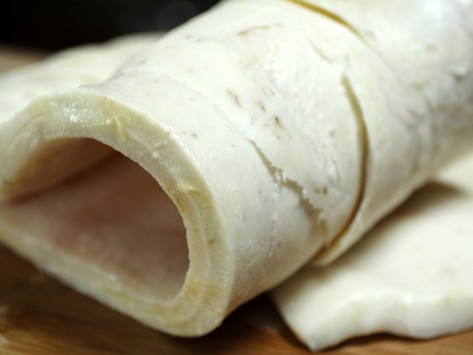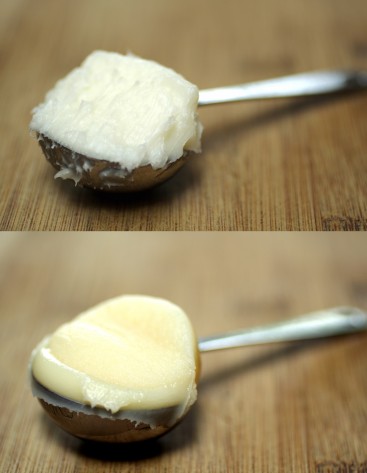Rendering Lard

Pork Fatback
I like lard. It gives a silky, luxurious texture to foods. (See my story on Thai stir-fried pork.) It has good keeping qualities and is stable when heated, making it an excellent choice for frying. According to Jennifer McLagan, author of the DCCC pick Fat, foods fried in lard absorb less oil than when fried in oil, making them crisper and, I suppose as a result, healthier. Lard, particularly leaf lard, is also prized for making pastry because its crystalline structure is said to create a very flaky dough.
Pork fat, I learned from McLagan, is good for us. It is mostly a monounsaturated fat in the form of oleic fatty acid—monounsaturated fats are known to help reduce the levels of LDL, the bad cholesterol—and it contains palmitoleic fatty acid, which has antimicrobial properties.
The less expensive replacement for lard, hydrogenated vegetable oil, has been around for more than 100 years. Its invention, effective marketing, and the USDA’s campaign against animal fats has worked to reduce lard consumption from 12.6 pounds in 1950 to just 0.4 pound in 1995 (Jennifer McLagan. Fat.) The trend away from eating lard has seen a slight reversal in recent years, which is promising for those of us who like to eat all parts of animals, and eat pure, natural foods.
It is unfortunate that lard has come to be thought of as something unhealthy, low-class, or even repugnant. Inspired by the DDDC pick Fat, I decided to render myself some lard.
The pinnacle of lard is referred to as “snow white.” Snow white lard is not only a pristine white color, it also is odorless, making it ideal for pie pastry and for frying chicken. When lard takes on color, it will have what many writers call a “piggy” smell and flavor. Such lard can be used for savory foods, but would add an unwelcome flavor in desserts. (Unless you want to expand on the bacon in everything craze, including desserts.)
When I made a few weeks ago, I let the fat begin to brown. The resulting lard has a definite creamy color and a “piggy” smell—I can see what all those writers are referring to now.

Top: “Snow white” lard; Bottom: slightly “piggy” lard, excellant for frying but not making desserts
The important thing to remember, I realized, is that “rendering” means to melt the fat—convert the solid fat to liquid—and just that. This requires the use of a low temperature and lots of time. It can’t be rushed. If the pieces of solid fat begin to brown, the liquid fat that you’ve extracted will taste of the animal the fat once resided on.
There are two main methods for rendering lard: the oven method or the stovetop method. Use the method that suits your temperament. For good reason, Jennifer McLagan prefers the oven method. It has the virtue of using more gentle heat, and needing less attention. For myself, I found it too easy to forget about the lard in the oven. I need the lard on the stovetop so that I can watch it carefully and not let it begin to brown.
Here are some basic pointers for prep and rendering lard on the stovetop, adapted from The Taste of Country Cooking by Edna Lewis:
Prep:
- Have the fat chilled or semi-frozen. It will be easier to cut.
- Cut away any streaks of meat, called “lean parts.” Meat left in the fat will contribute to a “piggy” flavor and aroma.
- Scrape off any reside or ink stamping on the skin side of the fat. The fat side will feel smooth; the skin side will be textured.
- Cut the fat into 1-inch cubes. Cut them as close to the same size as possible so that they render at the same rate.
Rendering:
- Place a ½ cup of water in a large heavy bottomed Dutch oven or other pot. The water will keep the fat from burning.
- Cook over medium-high heat, stirring constantly, until the fat begins to melt. Reduce the heat to medium-low, stirring often and keeping a close eye on the fat. Do not allow the fat to brown; reduce the heat to low, if needed. When the pork skin (cracklings) begins to brown and separate from the pieces of fat, it is nearly done. When all the cracklings have risen to the surface, strain the fat through cheesecloth-lined sieve into a heatproof bowl.
- Transfer the lard to jars and store in the refrigerator.
